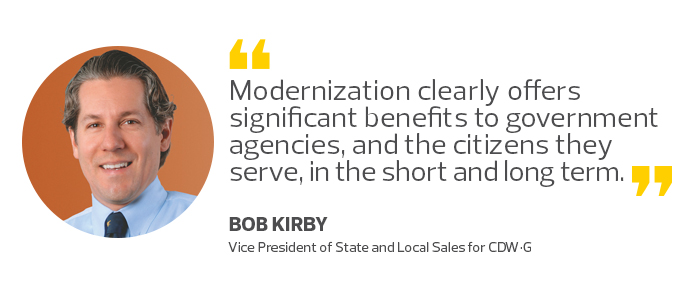IT Modernization Empowers Government to Innovate
In some government agencies, computer systems are older than the IT professionals working to maintain them.
This fact is on the minds of state and local decision-makers, who find themselves “trapped by expensive legacy software applications and IT infrastructures that are difficult and expensive to maintain,” according to an August 2017 report by KPMG.
At the NASCIO 2017 Annual Conference, state CIOs highlighted application modernization as a continuing concern. That sentiment echoed findings from a 2016 survey by NASCIO, Grant Thorton and CompTIA, which revealed that 90 percent of state CIOs believe at least 20 percent of their systems need replacement or modernization, while nearly two-thirds view more than 40 percent of their systems as a legacy.
“Despite the tremendous efforts undertaken by states over the past decade to modernize systems, it is clear that much remains to be done,” NASCIO states.
SIGN UP: Get more news from the StateTech newsletter in your inbox every two weeks!
Local IT Lags with Legacy Systems
Change can be difficult under any circumstances. Change that requires substantial investment and disruption of the status quo presents an even greater challenge. For people and institutions, inertia usually is the default mode.
Equipment and applications may be old, but if they aren’t broken, why fix them?
But things are broken. State and local IT teams face many of the same legacy issues as their federal counterparts, including complex IT structures, manual processes, insufficient visibility into systems and dwindling resources. That hampers innovation and hinders delivery of services to citizens. These factors point to a conundrum for budget managers: Saving money may require spending money.

In addition to better allocation of limited resources and simplified structure, modernization addresses the skills gap, a continuing challenge in IT. For older systems running on COBOL, a diminishing number of programmers remain who are adept in this decades-old language. Only a small number of universities still offer COBOL courses. Many programmers who have the expertise will be eligible to retire in the next few years.
On the security front — an increasing concern for state and local CIOs — hackers can take advantage of outdated systems to infiltrate networks for months before being noticed. Modernizing helps to reduce that window of vulnerability.
Cloud technologies work to strengthen patching and administrator passwords and provide greater insights into user activity and data moving across endpoints.
Modernization clearly offers significant benefits to government agencies, and the citizens they serve, in the short and long term.
CIOs Can Act as IT Advocates
That makes IT professionals uniquely suited to advocate for modernization; they should pick up the ball and run with it, and many are. More than one-third of state CIOs in the 2016 survey reported that more than 10 percent of their budget is allocated to modernization projects. That’s encouraging and should inspire public sector IT teams to do more.
Where to start? The survey revealed a key source to support modernization efforts: federal matching funds. As one state CIO explained, “We’re focused on areas where we are able to leverage federal dollars — like for Medicaid, with the 90/10 match.”
A successful modernization program also needs distinct goals and metrics to gauge progress. IT teams should begin small and build on early successes, which can help garner further leadership and public backing. With that methodical, well-planned approach, legacy infrastructure and applications will steadily give way to systems that power innovative and transformative government.








